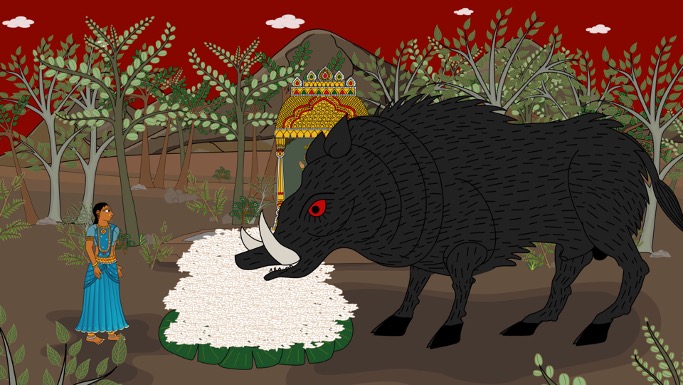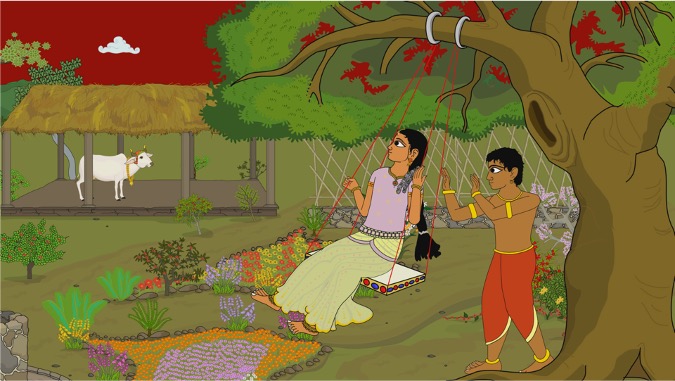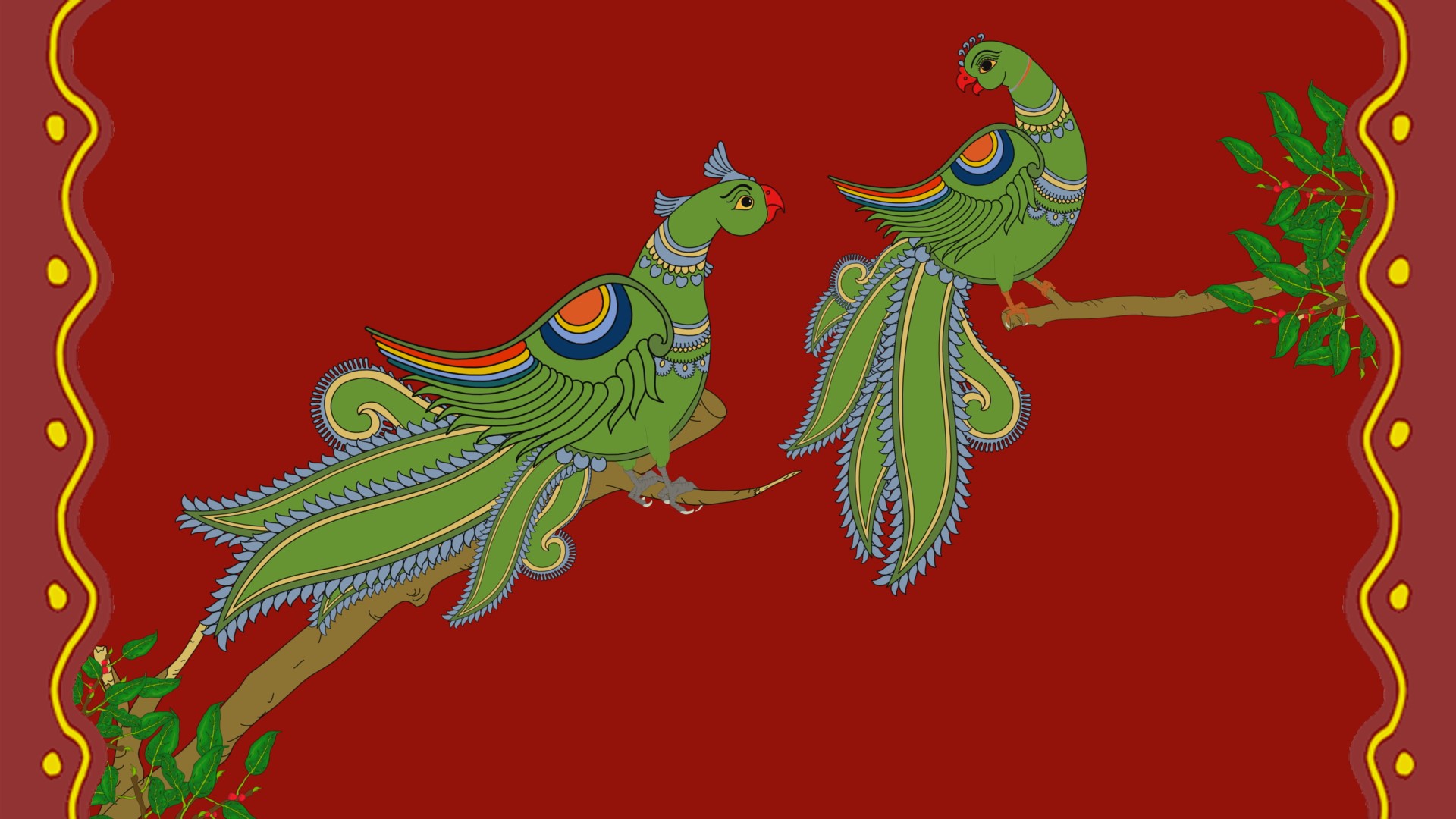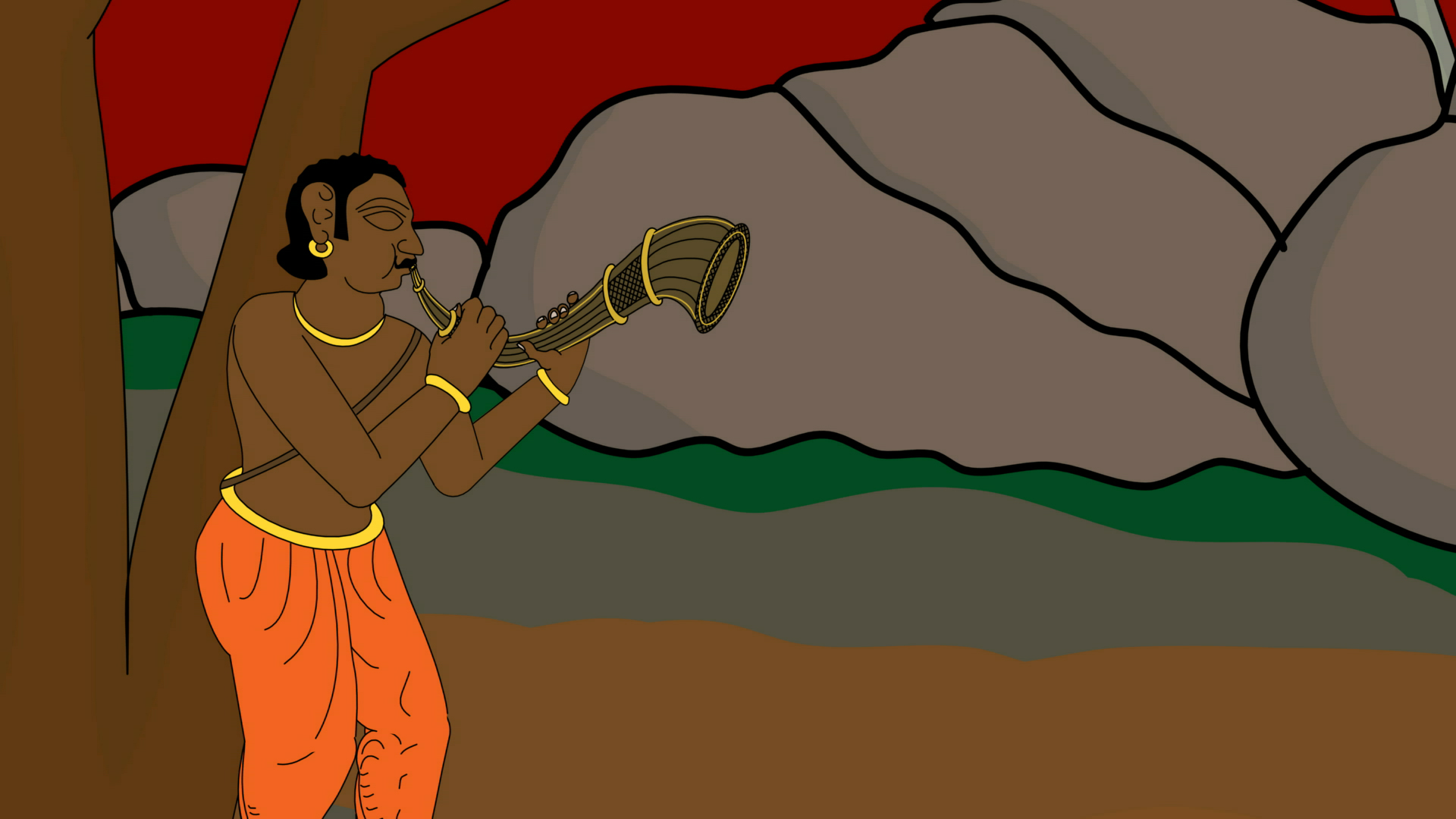Folktales
These tales describe events related to deities, animal-humans, monsters, magic trees and mistreated heroines. They mostly focus on family drama. Although these stories are fictive, they are often rooted in historical or geographical facts or events. Every tale has multiple versions. These stories, categorised as Migung, can be told by anybody and are not part of a ritual.
Tamil Transcription of the Perfor...
The oral epic, performed over a few nights in the 1960s, was about forty hours long and was transcribed into Tamil, much later, and that was 2400 pages. A key source in creating this exhibit is the Tamil Transcription from Brenda Beck’s archive available at the ARCE. The adjoining picture is the first page of the 2400 pages of the transcribed performance. These transcribed pages are useful to understand and contextualize the oral rendition of the performance.
Track Information : An invocation to Lord Vinayaka ushering the performance of the epic.Performer(s) : Erucanampalayam Ramasami and Olappalayam PalanisamiCollection : Brenda Beck CollectionKompan and Viratankal
Track Information : Viratankal asks if any of her maids said anything hurtful to him and cries “Kompa, you have left me alone and gone Why did you go and take shelter elsewhere?”Performer(s) : Erucanampalayam Ramasami and Olappalayam PalanisamiCollection : Brenda Beck CollectionEpisode 4 - Wedding of Muttupatta...
The concluding wedding sequence serves as a testament to the transformation undergone by Muttupattan, underscored by a juxtaposition with an earlier scene. In the initial scene, Muttupattan, positioned beneath a thatched roof, recites the Ramayana to an assembly of "a thousand Vedic Brahmins." This same setting reemerges during his wedding, but this time, the observers comprise his cakkiliyar in-laws. In a narrative continuum, the inaugural scene sets the stage for Muttupattan's departure from his Brahmin lineage. In contrast, the culminating wedding tableau achieves a narrative full circle, epitomizing Muttupattan's complete assimilation into a cakkiliyar family.
Track Information : Muttupattan Marries Pummakkal and TummakkalPerformer(s) : K. Patmanabhan & groupCollection : Stuart BlackburnTamarai and Kunnutaiyya
After years of wandering and suffering abuse, Kunnutaiyya is finally adopted by two kind, prosperous, farmer-brothers in the land of Valavandi Nadu. He works for them as their shepherd. One of Kunnutaiyya’s daily duties was to push the swing for Tamarai, the younger sister of the farmer Brothers, who was born of the Lord Shiva and Goddess Parvati’s union.
Track Information : A song describing Kunnutaiyya pushing Tamarai's swing. Oonjal in Tamil means Swing. The great swing is swinging for the chaste girl,
For Parvati, who is like a gold sculpture, who sways as she walks,
The great swing is rocking for Parvati,
For Parvati, who is like a tender garland,
Who walks as if she floats on air,
In the great swing Parvati,
The chaste girl is sleeping deeply.
Performer(s) : Erucanampalayam Ramasami and Olappalayam PalanisamiCollection : Brenda Beck CollectionPair of Parrots
Seeing Campuka, the first minister of the twins, approaching with his army to capture the parrots, the female parrot cries out in agony. In anticipation of her impending widowhood, she sings about losing auspicious markers of a married woman (turmeric and flowers) and ends her song with a poignant poem on separation.
Track Information : Will a tree separate from the earth, my Lord? Will shade separate from a tree, my Lord? Will the complexion separate from the girl, my Lord? Will the fragrance separate from the flower, oh, King?Performer(s) : Erucanampalayam Ramasami and Olappalayam PalanisamiCollection : Brenda Beck CollectionUdukkai and Jalra - Instruments
The Annanmar Katai is performed in the style of Udukkai (Hourglass Drum) Pattu (Song) in which the singers use the Udukkai and a pair of finger cymbals as musical aids to their narration. The lead bard narrates while keeping time with the finger cymbals, and the assistant bard repeats end-phrases or song lines after the lead bard while playing the Udukkai. The songs are accentuated by complex rhythmic patterns played on the Udukkai in addition to introducing dramatic episodes or cinematic pauses as part of the performance. When played together during the performance, the Udukkai and the Jalra create a syncopated effect. This section describes the body of the instruments with audio examples.
Track Information : This is a lament on losing the marks for an auspicious woman on account of being widowed.Performer(s) : Erucanampalayam Ramasami and Olappalayam PalanisamiCollection : Brenda Beck CollectionSeven Deaths of Tamarai
Tamarai, the mother of the three twins, to beget a boon for offspring, from Lord Shiva embarks on a long pilgrimage to Kailasa, the abode of Shiva. With the help of Lord Vishnu, she begins her arduous penance as part of which she loses her life seven times after which Shiva grants her a boon for three twins, ‘two boys for the field and one girl for the home.’ The seven deaths and subsequent rebirths of Tamarai are in line with the curse of barrenness for seven generations which the first-generation farmer-migrant, Kollatha got from Shiva for killing innocent cows that grazed on his farm.
Track Information : This dramatic scene describes Tamarai’s penance, Lord Shiva causing one of her ‘deaths,’ and Lord Vishnu resurrecting her back to life and then the next iteration of her penance.Performer(s) : Erucanampalayam Ramasami and Olappalayam PalanisamiCollection : Brenda Beck CollectionBad Omens
Of the seven artisans who were scheming to end the lives of the second-generation farmer couple, parents of the three twins, Kannutaiyya and Tamarai, one survived. With the grace of Vishnu, Kannutaiyya, and Tamarai survived, and six of the seven artisans involved were killed. This poem on bad omens occurs when the seventh artisan conspires with Vettuvas (the community of indigenous hunter-gatherers in the story) to deceive the third-generation farmers, the three twins.
Track Information : A woman who had left her husband Carried the hot coals left (from a fire) A good cat crossed The artisan’s path, crossed it A good jackal, crossed it The artisan’s path, crossed it A single Brahmin came towards him The artisan, came towards him there.Performer(s) : Erucanampalayam Ramasami and Olappalayam PalanisamiCollection : Brenda Beck CollectionCampuka's Lullaby
Lord, rari, rari, rararo
You were born of a boon,
Have you come like Bhima with a sword?
You were born as a result of penance
Oh, brave one, have you come?
You were born of Kunnutaiya
Lord, have you come with the strength of an elephant?
Have you come as a murderer
To destroy Kompan, Lord?
Have you come as an avenger to kill the boar, Lord?
You will spear Kompan, oh, Lord
And divide him into seven partsTrack Information : In a cleverly worded lullaby, Camuka sings to the Boar about killing Komban and cutting him into seven pieces to which the boar awakens and questions Campuka. In response, Campuka blames the bent horn for the misheard lyrics of the song which the Boar believes.Performer(s) : Erucanampalayam Ramasami and Olappalayam PalanisamiCollection : Brenda Beck Collection












